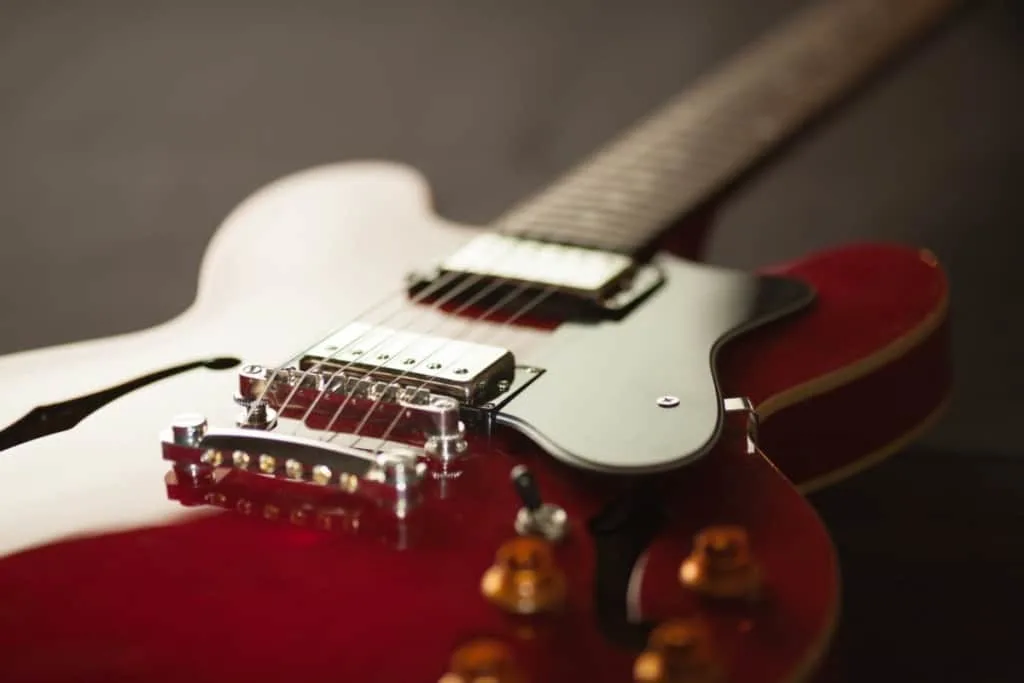Wondering how to tune an electric guitar to standard tuning? Can you tune a guitar to other tunings? What are the easiest and most reliable ways to tune a guitar?
If you’re here, it probably implies that you’ve decided to pick up the guitar and learn the instrument. Congrats on making a rewarding choice. Before you proceed to learn the guitar, you will need to learn how to tune it. That’s what we plan to help you out with.
When we all begin our guitar journey, tuning feels like an intimidating task. Luckily, it gets easier over time and your reliance on tuners and other means of tuning will feel redundant. Tuning an electric is similar to tuning an acoustic guitar with some minor differences that we’ll highlight.
In this post, we’ll discuss the must-know things about tuning an electric guitar with a brief overview of the methods and tunings available.

Electric Guitar Tuning For Beginners:
Electric Guitars are made from wood and any change in temperature or humidity will affect their tuning. You may also knock the tuning pegs while taking the guitar out of the gig bag or placing it back.
Anyone who has been playing the guitar for long enough will be aware that new strings tend to go out of tune fairly often in the beginning. Other reasons for detuning can involve resting the head against the wall, using alternate tunings, poor construction, and rigorous playing sessions.
Regardless of the reason, there are many surefire ways to tune your guitar and ensure that it stays in tune so you enjoy your playing experience. You can tune a guitar using the following methods:
- A tuning fork or reference pitch (piano or other instruments)
- A tuner – pedal, clip-on tuner, etc.
- A tuning app on your smartphone
- Online Tuners
What Is The Standard Tuning For An Electric Guitar?
Before you learn how to tune a guitar, it is important to know what notes it ought to be tuned to. An electric guitar, much like an acoustic guitar, is tuned to EADGBE. This is called the standard tuning with the thinnest string (1st string) being tuned to E, the 2nd string (from below) being tuned to B, and so on.
Here is a clear way to understand it: E – Thickest String – 6th String, A, D, G, B, and E – Thinnest String – 1st String. There are several mnemonics to remember the string order and names. Here are a couple of my favorites:
- Every Amateur Does Get Better Eventually (It helps to keep telling yourself that!)
- Eddie Ate Dynamite. Good Bye Eddie.
- Eat All Day Get Big Easy
How To Tune An Electric Guitar With A Tuner?
As we mentioned, electric guitar tuners are available in various avatars.
From the Donner Clip-on Chromatic Tuner to the KLIQ TinyTune Chromatic Pedal Tuner, you can select from a wide range of options based on your budget and needs.
Once you have a tuner, you can connect it to your guitar as mentioned in the user manual.
If it is a clip-on tuner, you will clip it on to the electric guitar’s headstock. In the case of a tuning pedal, you will connect the guitar to the pedal using a ¼” jack. Once your guitar is connected, you can power up the tuner are ready to begin.
Start with the E string and strike it with your plectrum.
Ensure that you don’t hit any other string as this will lead to an inaccurate reading in the tuner. You should only strike the string that you intend to tune. Once you do so, the tuner will display the note that your string is tuned to.
If your string is in tune you can move to the next one.
If it isn’t, you must observe if the string needs to be tuned up or down. For instance, when you strike the E-string, your tuner may read D# or F. If it is D#, the string needs to be tuned up and if it is F the string needs to be tuned down.
You will notice there are six tuning pegs (or tuning machine) on your electric guitar’s headstock. Each tuning machine is attached to the string that it will tune. If you rotate the head clockwise, it will raise the pitch and if you rotate it anti-clockwise it will ‘drop’ the pitch.
Therefore, if you see D# on your tuner when you strike the E string, it means your string has dropped tuning by a semitone. If your tuner’s screen displays an F when you strike E string, it means your string is a semitone higher than it should be. i.e. D# is a semitone below E and F is a semitone above E.
- Using this method, you can tune the strings on your guitar to the standard tuning EADGBE.
Once you are done, tug on each string gently (pulling it away from the body) and check the tuning again. You may have to fine-tune it a second time. This part (stretching the strings) is optional but it ensures that your guitar will hold tuning for longer.

If you are looking for a good hardware tuner, I highly recommend the Fender FT-2 Clip-On or D’Addario Eclipse Headstock Tuner. You can also find Chromatic tuners like Pano Tuner and Pitchlab and paid versions like Cleartune and Tunable in the app stores for your smartphone.
Best Free Online Electric Guitar Tuners:
Alternate Tunings For Electric Guitar:
Famous guitar players like Jimmy Page (Led Zep), Keith Richards (The Rolling Stones), and blues virtuoso Derek Trucks have used alternate tunings in many of their songs. These tunings are unique and allow a guitarist to play voicings that would not be possible in standard tuning.
However, it should be noted that these are meant for intermediate to advanced guitar players. Changing the tuning of your guitar frequently will change the string tension on your guitar neck. You should ensure that your guitar is set up to accommodate this before you experiment.
That said, let’s take a brief look at some of the common alternate tunings:
What is Drop D Guitar tuning?
Drop D, as the name signifies, is when you drop the E string (either one or both) to a D note (two semitones or one whole tone). Many guitarists use drop D tuning to make it simpler to play power chords. Drop D is popular in genres like blues, rock, and metal.
What is Open G Guitar Tuning?
The Open G tuning – DGDGBD – is an ‘open tuning’ because you will sound a G major chord when you play the guitar without fretting any string. Keith Richards from the Rolling Stones is said to have ‘invented’ the tuning. You’ll find it used in many hit numbers like Brown Sugar, Jumping Jack Flash, and Paint It Black.
What is DADGAD Guitar Tuning?
DADGAD tuning is often associated with fingerstyle folk; Jimmy Page used it in Led Zeppelin’s epic Kashmir riff.
The notes of the tuning form a Dsus4 chord (D G A), and, though it may feel alien at first, its rich, open sound is very rewarding. Notice the semi-circular ‘anti-accent’ lines under certain chords; these tell you to play more gently.
Related Questions: Guitar Tuning FAQ
Do you tune an electric guitar like an acoustic guitar?
The basic idea behind tuning an acoustic guitar and an electric guitar is largely the same.
The methods for tuning the two may vary based on how you wish to proceed. Acoustic guitars often have a built-in tuner in the control panel that isn’t found in electric guitars. Electric guitars, on the other hand, can be plugged into tuners or tuning pedals via a jack/cable, which would not be possible with an acoustic guitar without electronics.
Take a look at my article on the differences between tuning an acoustic and an electric guitar. You can read it here.
Why won’t my guitar stay in tune?
Guitars can frequently go out of tune if the strings are either very new or old (think rusted).
Some guitar components or construction issues can cause this problem too. A poorly seated nut, a rickety bridge, and poor quality tuning pegs (or machines) can also cause this problem.
Besides this, poor playing technique, changing climate, and using a tight capo can also throw off your guitar’s tuning.
Is intonation the same as tuning?
Tuning and intonation are related concepts, but they have a very different meaning.
We’ve already explained that tuning is the calibration of a string to a particular pitch. Intonation, on the other hand, refers to the notes being in tune as you move along the fretboard.
Most low-to-mid range (price) guitars have slightly varying intonation, especially as you go higher up on the fretboard. This is considered normal. The difference is barely audible to an untrained ear.
Check out this article on how to keep your guitar in tune.
Take a look at this video. It teaches you the difference between tuning and intonation.
What is DADGAD? How to tune a guitar to DADGAD?
DADGAD is a modal tuning that sounds like the Dsus4 chord when you play the strings without fretting any of them. #
It is commonly used in folk tunes, indie music, and has been favored by some singer-songwriters. However, it is not meant for beginners as the chord shapes, scales, and theory for standard tuning (EADGBE) will not apply to DADGAD tuning.
Final Thoughts On Electric Guitar Tuning
I hope that will help you with many, if not all, your tuning-related queries.
You should form the habit of checking your tuning between songs as it can save you some embarrassment when you start performing.
As you progress with your ear training, you’ll learn to tune the guitar with relative pitch – using one string to tune the remaining five strings.
Remember, grow your ear before you gear!
